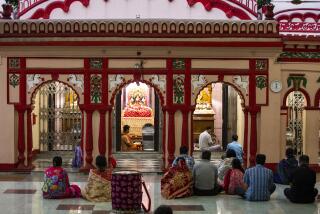Posh High-Rises Tower Over Poverty : Bangladesh: Luxury apartments in Dhaka cost what average worker would make in 500 years. Nearby, families live in shanties over open sewers.
- Share via
DHAKA, Bangladesh — High-rise apartments have arrived in Dhaka, heralding a social and building revolution for the prosperous few in one of the poorest nations on Earth.
In the shadows of 18-story luxury towers that have given Dhaka a skyline for the first time in its 1,600-year history, some of mankind’s worst miseries are multiplying at a rate that seems to defy help.
Whole families sleep on the sidewalks, sometimes with a bit of shelter from a small, fraying straw mat molded into an arc over their bodies.
Shanties smaller than a compact car stand on bamboo stilts above open sewers, where industrial and human waste congeal in stinking globs a few inches below gaping slats where people cook and sleep.
Nearly a score of high-rise apartment buildings are occupied or nearing completion, interspersed among the slums, offices and shops of downtown Dhaka.
They are tangible proof of an expanding upper class willing and able to spend up to $85,000 for an apartment. The average Bangladeshi would have to work 500 years sweeping floors, pedaling a bicycle rickshaw or toting gravel at a construction site to earn that much money.
The high-rises are introducing new lifestyles to a society in which three generations of a family have traditionally lived under the same roof, with younger people caring for the elderly.
Najma Chowdhury, a 43-year-old widow who is marketing the nation’s first beeper paging systems, was among the early buyers.
In March, 1987, when Walsow Towers was little more than an empty plot of ground and an architect’s sketch, Chowdhury put down the first monthly installment on her $52,000 apartment, which has three bedrooms.
“Right now, it’s an investment, and I plan to rent it, but I bought it for me because someday I’ll be needing it,” she said.
Chowdhury, who lives with her 62-year-old mother in an upper-class neighborhood, said she will stay in the family home while her mother lives. After that, she doesn’t want the security worries and servant hassles that accompany a big house and garden.
High-rises also provide a partial answer to overcrowding in the capital, at least for people with money.
Dhaka proper has 6 million people in 90 square miles. So-called “statistical Dhaka” includes two adjacent factory towns, which contribute another 1 million.
Within the city limits, the population density is 66,666 per square mile, “but that includes big open spaces like the (military) cantonment and posh residential areas,” said Nazrul Islam, professor of urban geography at Dhaka University.
“In the slums, the density is 2,000 per acre.” Islam said. “In Europe, construction is planned for 100 people per acre.”
He estimates that 30% of Dhaka’s people have middle- or upper-level incomes, which Islam bases on expenditures, not earnings, of up to $2,000 a month. The rest earn a maximum of $84 a month, according to his research.
“Anybody who earns less than this ($84) cannot rent an acceptable shelter,” he said. Islam’s definition of acceptable is a shelter with electricity and drinkable water.
Government housing programs have made only a tiny dent in Dhaka, where an estimated 1 million people live in shantytowns owned by slumlords. An additional 400,000 are squatters who can dismantle their bamboo-pole huts in 15 minutes or less when bulldozers come to evict them.
Last year, the government created a “city village,” a sort of barracks with running water and electricity near the railroad tracks, where the rent is about $2.75 a month. The problem is that it houses only 272 families--about 1,600 people.
More common are areas like Paltam, one of hundreds of flimsy bamboo-hut shantytowns that spring up on every conceivable spot of ground. Huts in Paltam, which straddles a sewer ditch, rent for $4.10 a month.
Zamila lives in one with her 20-year-old daughter, Zulikha, and Zulikha’s 2-year-old son, Osman. Their husbands have vanished.
The family’s only regular income is the $5.50 a month Zulikha earns as a housemaid. She is also allowed to bring home leftover food.
Shamsul Arifin, who has constructed buildings of up to 12 stories, thinks vertical expansion is good--for the rich. Like Islam, the urban geographer, he says the poor would have to be trained to live in high-rises or the buildings would become towering, filthy ghettos.
Sooner or later, some sort of safety standards should be required for high-rises, said Arifin, who has a master’s degree in engineering from Hiroshima University in Japan.
“The City Council has no control or inspection of the structure,” he said. “Basically, it’s been safe because Bangladeshi engineers have strictly followed the American requirements and because of the small quantity of buildings going up.
“But, if I were living on the 18th floor, I would be very worried when there is an earthquake.”
More to Read
Sign up for Essential California
The most important California stories and recommendations in your inbox every morning.
You may occasionally receive promotional content from the Los Angeles Times.












